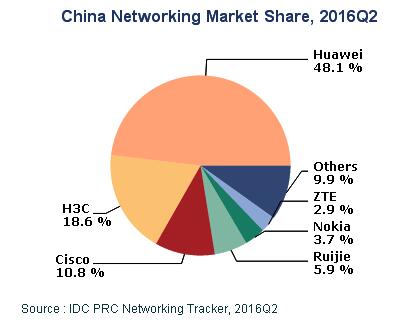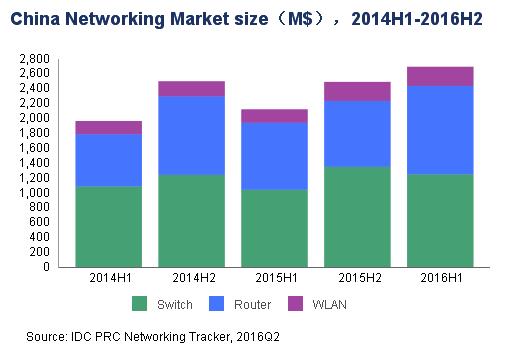China networking market grew 27% in 2016H1, with Huawei & H3C making the biggest gains
China’s networking market expanded by 27% year-on-year in the first half of 2016, with over 80% of the gain going to Huawei and H3C, leading to a further increase in market concentration, according to IDC PRC Networking Quarterly Tracker, 2016Q2, a quarterly report released today.
China’s networking market is now an oligopoly, with growth driven be a few players as strong vendors get stronger.

China’s networking market grew by US$ 60 million in 2016 H1, the report shows. Huawei’s growth mainly came from telco router and enterprise network data center switch markets, while H3C derived its growth from the enterprise network switch and wireless markets. Thanks to the construction of cloud data centers and investment in broadband networks, the Internet, government and telco segments all grew rapidly, while other sectors performed steadily.

In 2016H1, China’s switch market reached US$1.24 billion, up by 19.8% year-on-year. Most of the gains came from the Internet and government sectors. The Internet segment, represented by BAT (Baidu, Alibaba & Tencent), accelerated its investment in cloud infrastructure and migrated its products to 10G/40G/100G. The Chinese central government has increased its ICT investment in 2016, the start year of China’s 13th Five-Year Plan period, and local governments started to build their government cloud data centers. With Brocade’s acquisition of Ruckus, all leading network vendors have developed comprehensive portfolios of switches, routers and wireless products, leading to a growing trend in the integration of cable and wireless products.
As for routers, China Mobile has stepped up its broadband network construction and drastically increased its investment in backbone networks and MANs (metropolitan area network), according to the report. Thanks to these efforts, China’s router market grew by 32.2% year-on-year in 2016H1 to reach US$1.19 billion. The enterprise network router market maintained fairly fast growth in the Internet, government and power sectors. H3C was active in the telco router market, and has gained itself a place on China Telecom’s centralized procurement roster. Building on its success with T8000, ZTE has made breakthroughs in the telco core router market, presenting a new challenge to the existing market landscape.
Compared with the switch and router markets, the wireless network equipment market has grown even faster. In 2016H1, China’s wireless market rose 42.6% year-on-year to reach US$ 260 million. Retail, manufacturing, education, government and transport were the fastest-growing sectors. Large-scale deployment of 802.11ac products occurred in 2016H1 and they now have a bigger market share than 802.11n products. And 802.11ac Wave2 and Wave3 RF products have now started to enter the market, offering more solutions for high-density scenarios. Wireless networks have also gradually begun to spread from entertainment and office networks to infiltrate business and production networks, and users are becoming more dependent on wireless networks. As commercial Wi-Fi has generally struggled to become profitable, some vendors have started to try Wi-Fi operation services and have made good progress through forward network charges plus backward marketing. As Cisco Meraki has had great success in Europe and the United States, China’s cloud wireless market will also embrace a new turning point.
Steven Hu, Networking Market Research Manager at IDC China, remarked, “In their migration to the cloud, users no longer need just hardware but total solutions. The business model in the networking market has also gradually changed from hardware sales to service provision. Cloud networks represent a positive exploration on the way to SDN and a major innovation in future network development.”








